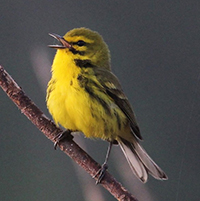Wildlife - Species
Prairie warbler (Setophaga discolor)

Description
A small yellow breasted warbler, a little more than 4 inches in length. Black streaks on the sides, and 2 black lines on the face, one below the eye and one through the eye. The male has small brownish marks on the back. This warbler bobs its tail (as does the Palm warbler, but Palm warblers have very clear white wing bars).
Voice
A characteristic thin "zee zee zee zee zee zee zee zee" up- scale. See Bird-Sounds.net for recordings of 602 species of bird calls in the U.S. and Canada. There are also a number of apps available that will identify bird sounds.
Habitat and Food
The Prairie warbler is found in brushy and shrubby areas including young pines and overgrown pastures and fields. Typical food items include insects, spiders and other invertebrates. They forage on leaves and stems of plants, and sometimes catch prey items in the air.
Nesting
Prairie warblers are one of the earlier migrants in spring and fall. They nest in eastern states including South Carolina, and winter in Florida and Central America. The nest is of open construction, usually less than 10 feet from the ground in trees and shrubs. Two-five eggs are generally laid.
Additional Information
Amy Tegeler – Bird Conservation Coordinator
SCDNR
P.O. Box 23205
Columbia, SC 29224
Phone: (803) 521-2119
E-mail: TegelerA@dnr.sc.gov
